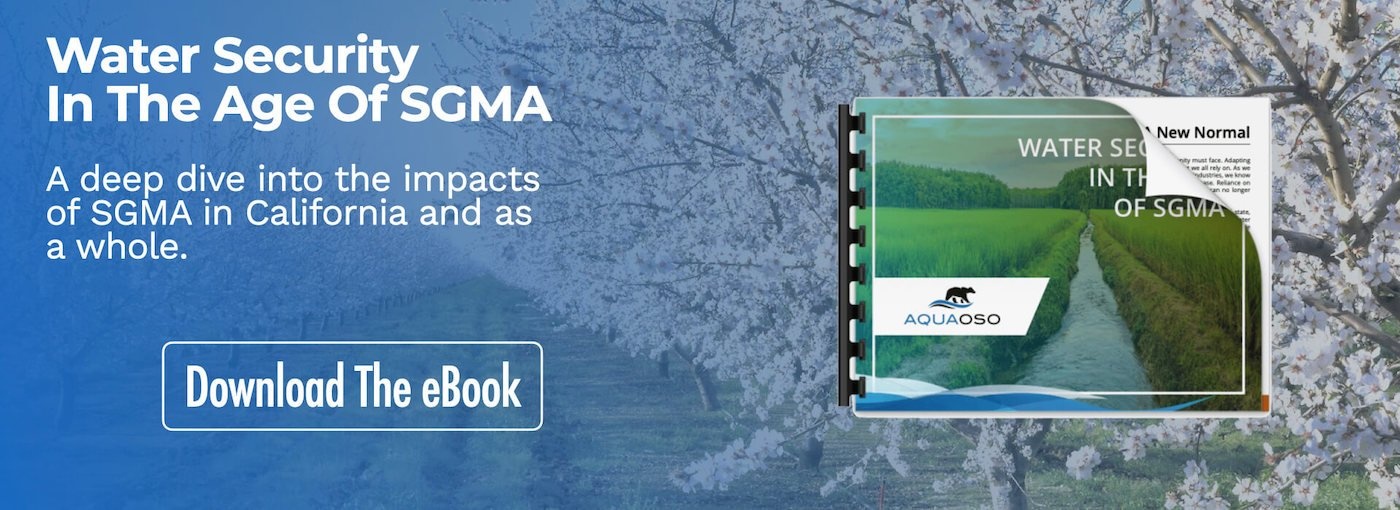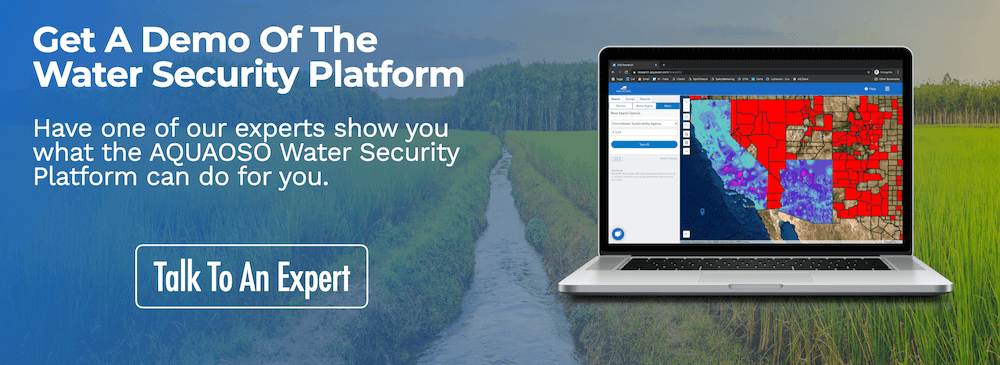How Riparian Water Rights Work In Ag Lending And Investing
Part of our Water Rights Guide
In many parts of the world facing increased water scarcity, including the American West, the right to use the water associated with a piece of agricultural land is not guaranteed. Each state has its own system of water rights that may prioritize senior rights holders or water conservation measures over unrestricted agricultural use.
This means that the amount of water available on a given property is dependent not just on rainfall or streamflow, but on water rights as well. As Nature magazine explains,
“Water rights shape crop yield and revenue volatility tradeoffs… A warmer climate is expected to reduce snowfall and increase rainfall, reducing snowpack volume… This can lead to curtailment (or interruption) of water rights for irrigation, thus producing an indirect water scarcity effect from climate change on crop yields.”
Water rights vary from state to state, and two of the most common ones are: appropriative and riparian. This article takes a close look at riparian water rights and why it’s so important to understand them in the context of agricultural lending and investing.
What Are Riparian Rights?
In many U.S. states, all water resources – including surface water and groundwater – are owned by the public. Agricultural users must apply for a permit in order to use the water on their property, and they must put the water toward a “beneficial use.”
Water rights can be either riparian or appropriative:
- Riparian rights, according to California Water Boards provide the right to use “the natural flow of water” on “land that touches a lake, river, stream, or creek”
- Appropriative rights provide the right to divert or “appropriate” water to be used elsewhere and are based on seniority rather than proximity
Most states east of the Mississippi River use a riparian rights system, while most states west of the river use an appropriative system. California uses a hybrid system, in which rights that were established before 1914 are primarily riparian, while rights established after 1914 are appropriative and ranked in order of seniority, or “priority date.”
How Riparian Rights Work
Riparian rights are typically considered stronger than appropriative rights because they aren’t based on seniority and they aren’t lost if they aren’t used. In California, a property owner who isn’t exercising their riparian rights may still have a dormant riparian right that they can start using at any time, even if it impacts other users on the same river or stream.
This is in contrast to appropriative rights, which often require the rights holder to make use of their full allocation each year in order to maintain it.
Can You Lose Riparian Water Rights?
It is possible to lose riparian rights in the process of subdivision or transfer of property. A riparian right is associated with “the smallest piece of land that touches a water source,” so if a property is subdivided and sold, any parts that don’t touch the water source may lose their water rights.
Unlike appropriative rights, riparian rights can’t be sold separately from the land. However, a parcel of land can be sold without transferring the rights attached to it. This means that it’s important to check the chain of title before assuming that a piece of land comes with riparian rights.
The water can only be used on the parcel that is connected to the water source, and if the property is reattached, water rights won’t be restored to the full property. As the CA Water Boards explains, “Once it is lost, a riparian right can almost never be restored.”
Limits on Riparian Water Rights
Another limitation associated with riparian rights is that they don’t extend to diversion and water storage. The rights only apply to the “natural flow” of water, which means a riparian water source may not be available year-round.
The Water Education Foundation describes how this can impact the economic viability of the property: “riparian rights could be attached to moderately productive agricultural land, but would not be transferable to neighboring non-riparian farmland where water could produce more and higher-valued crops.”
Why Riparian Rights Matter to Lenders and Investors
Riparian rights can add significant value to a parcel of land, but they aren’t a guarantee of reliable access to water resources. It’s especially important not to take a property title at face value, because any changes in riparian rights may not be shown on the deed.
Due diligence is valuable to lenders and investors because it helps ensure that a piece of land hasn’t been subdivided and stripped of its water rights in the process. Again, a main point rings true: people don’t buy land, they buy access to water.
It’s also worth looking into the overall water risk of the property, and finding out whether adjoining properties have dormant riparian rights that could be claimed at any time. This can reduce the amount of water available for agricultural use, especially if a period of drought or dry weather drives up competition for water resources in the basin.
Without reliable access to water resources, the value of the land will go down and will be difficult to farm on or to sell – turning an investment into a liability.
How AQUAOSO Can Help
Researching water rights is a complex process, in part because their systems vary so much from state to state, but also because accurate data on specific parcels of land can be hard to find. Certain states may have their own portal for looking up water rights, and multiple site visits would probably be necessary to access data on water rights in an effort to evaluate water risk.
In addition, specific watersheds may have their own regulations and restrictions, as well as incentives for reducing water use in periods of low streamflow.
AQUAOSO can help by providing a centralized database to research water rights on a parcel-by-parcel basis. The Water Security Platform is designed to support agriculture investing and lending’s due diligence and research, providing the information needed to make better agricultural investments.
Data from various sources is aggregated into the Water Security Platform and its GIS research tool. View the regions we serve here. The Water Security Dashboard can be used to share data with other stakeholders, and factor water risk directly into investments and loans.
Read more about state-by-state water rights systems and how they impact lenders and investors in our Water Rights Guide.
The Bottom Line
AQUAOSO believes that a better understanding of water rights is key to making smart investment decisions. By providing actionable water risk data, the company’s goal is to help our clients improve their bottom line while also inciting growers to make more efficient use of scarce water resources. With better data, stakeholders at all levels of the agricultural sector can work together to create a more water-resilient future.
Contact us for a free demo of our Water Security Platform, or browse our resources to learn more about water rights, water risk, and other agricultural lending issues.
Recent Posts
Sustainable Agriculture Practices That Need Financial Capital
In late 2021, world leaders gathered in Glasgow for COP26, better known as the UN’s climate change conference. With over 25,000 attendees meeting to discuss the efforts needed to address climate change, themes of sustainability, renewable energy and the reduction of...
2022 Sustainable Agriculture Trends for Ag Finance to Be Aware of
With real-world impacts like rising global temperatures, climate change is one of the biggest risk factors agriculture faces today. NOAA reported that 2020 was the second warmest year and the EPA explains a consistent increase of 0.16°F in average surface temperature...
Crucial Ways Agricultural Bank Services Can Contribute to A Sustainable Ag Economy
Ag banks and Farm Credits, enable agribusinesses to attain the financing they need in order to execute functions like harvesting and planting, as well as buying new equipment and combat overhead costs. They allow farmers to operate by engaging in a relationship with...






